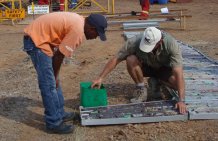
Research into new rare earth ore deposits is necessary to ensure the security of critical metals.
Critical research into rare earths highlighted in international journal
University of Exeter research to ensure the security of critical metals has featured in a high profile international publication.
Elements Magazine is produced by a group of 15 mineralogical and geochemical societies and is read by 15,500 earth scientists worldwide.
The current issue was co-edited by Anton Chakhmouradian (University of Manitoba, Canada) and Frances Wall (Head of Camborne School of Mines), and focuses on rare earth elements. Rare earths are a set of 17 elements in the Periodic Table that are essential in many new and ‘green’ technologies: in every computer, car, and television, in low energy lighting and in permanent magnets for large wind turbines.
In 2010 China announced a cut in exports of rare earth raw materials, and it was realised that China had a position of complete market dominance, supplying 97 percent of the rare earths used throughout the world. Prices rocketed, exploration companies raced to find new ore deposits, and ‘security of supply’ of specialist raw materials became as important a concern as price.
Frances Wall and Anton Chakhmouradian have brought together ten colleagues from academia and industry to write six articles about rare earth ore deposits to explain why they are important, how they form, where they are found, and the difficulty of starting a new rare earth mine.
The first article is an introduction to rare earths: their occurrence in nature, mines, uses and history. This is followed by an article giving the story of the recent volatile market for rare earths, two articles on how rare earth deposits can form beneath volcanoes and from hydrothermal fluids in the earth and two articles about particular regions. The first region is China, and the other is North America, where there is intense effort to find new ore deposits and to re-open a large mine.
Professor Wall said: “I am really pleased that Elements Magazine chose to highlight Rare Earths in this issue. Anton and I are already receiving feedback from students interested in studying this topic further and from researchers in related areas, such as medical geology, sending us more information from their own studies.”
In December 2011, the University of Exeter began a collaboration with the British Geological Survey on research into the geology of rare earths. This alliance is intended to improve the research capability of both organisations to address growing concerns in the UK and Europe over security of supply of critical metals. View the Camborne School of Mines research pages for further details of current research in this area.
Date: 9 November 2012
